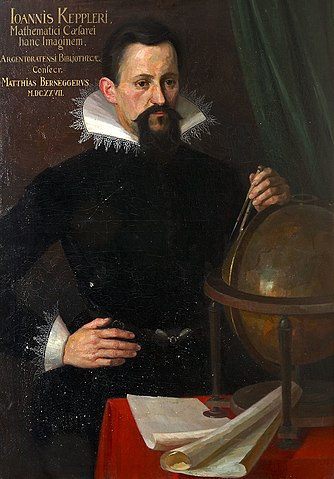Johannes Kepler

Credit: Wikimedia
Occupation: Astronomer, Mathematician, Scientist, Teacher
Year born: 1571
Research Areas: Planetary motion, optics, geometry
"I was almost driven to madness in considering and calculating this matter. I could not find out why the planet would rather go on an elliptical orbit. Oh, ridiculous me!"
Source: John Freely, Before Galileo: The Birth of Modern Science in Medieval Europe (2012), Ch. 58.
Early Life
Johannes was born in Weil der Stadt (now part of Germany). He had an interest in astronomy from a very young age. When he was 6, his mother took him up to a high place to see the Great Comet of 1577. When he was 9, he was called outdoors to see a lunar eclipse. His family were poor, but Johannes got a scholarship to study at the University of Tübingen.
At University, Kepler earned a reputation as a good mathematician and astronomer. When he was 25, he published some of his earlier work in the ‘Mysterium Cosmographicum’. At this time, he was working as a maths teacher.
Career Highlights
Johannes was interested in the work of Nicolaus Copernicus, and the Sun-centred model of the Solar System. At the time, the ideas were purely mathematical and had no observational evidence to support them.
Johannes set out to find evidence for the Copernicus’ model. When he was 29, he contacted Tycho Brahe, and asked him to share his most detailed studies of the motions of the planets. Tycho invited Johannes to stay with him at his observatory but was suspicious and would not share his work. Eventually, Tycho agreed to pay Johannes to work with him to try and solve the problem of why Mars appeared to move backwards in the sky. However, it was not until after Tycho’s death in 1601 that Johannes got full access to the detailed notes he needed.
Using Tycho’s data, Johannes worked out that the planets do not orbit in circles but in ellipses. This became known as Kepler's First Law of Planetary Motion. He found that Earth had a small, almost circular orbit, and Mars had a more distant, more elliptical orbit. The Earth would come from behind Mars, catch up, and eventually pass the planet. This caused Mars to appear to travel backwards through the night sky, a motion called ‘retrograde’.
Johannes worked on other astronomical problems in his later years. When a planet is closer in its orbit to the Sun, the planet moves faster. When it is further away, the planet moves slower. This became Kepler's Second Law of Planetary Motion. His Third Law states that the time a planet taken to orbit the Sun is connected to the planet's distance from the Sun.
Johannes was also interested in optics, the science of light. His experiments showed the path that light takes through the eye. He also found that the intensity of light decreases with the square of the distance it travels.
Legacy
Johannes’ 3 Laws of Planetary Motion led the way for Isaac Newton’s work on the force of gravity.
A crater on the Moon, a crater on Mars, and an asteroid are all named after Johannes. A NASA space telescope which searched for exoplanets was named the Kepler space telescope in his honour.
Other Interests
Johannes spent a lot of time thinking about the maths of music and shapes. He sent a friend the first description of the symmetry of snowflakes as a gift.

